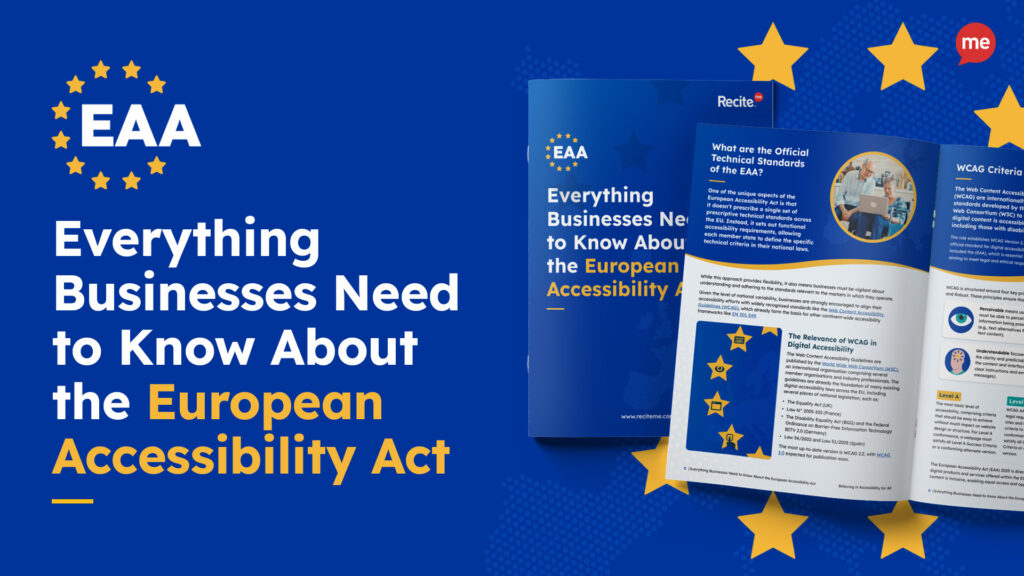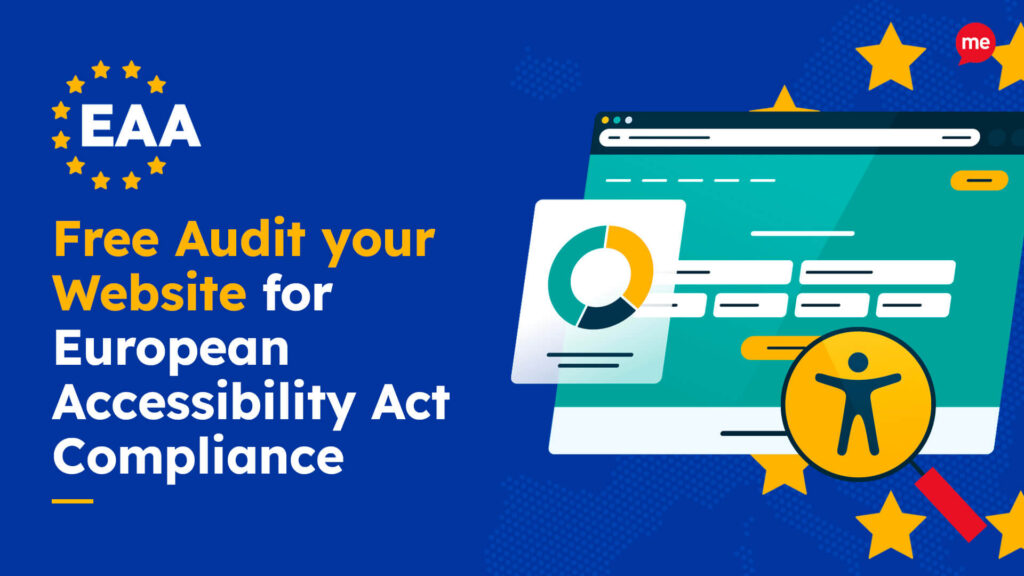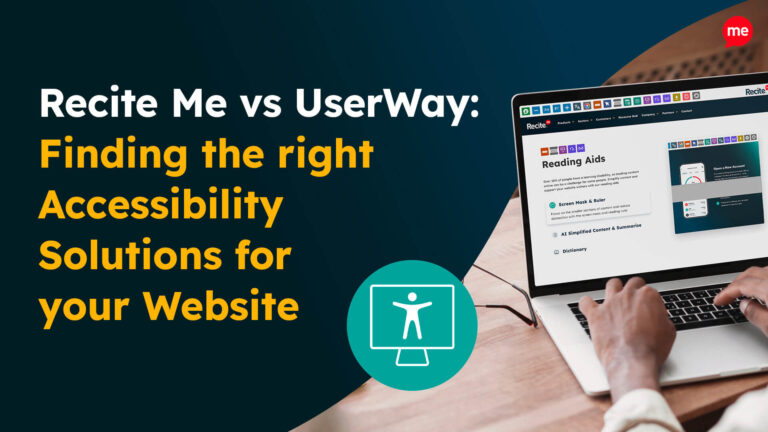Get Your Free European Accessibility Act Checklist
Download NowThe European Accessibility Act (EAA) is changing the way digital services and products are delivered. But it’s not just EU-based companies that need to pay attention. UK businesses that operate in or sell to EU markets may also be required to comply.
In this guide, we’ll explore how the EAA affects UK businesses, outline key deadlines, and detail the practical steps you can take to meet the necessary accessibility standards.
What is the European Accessibility Act?
The EAA establishes minimum accessibility requirements across the EU, with the aim of removing digital accessibility barriers for people with disabilities. The directive sets a common framework based on the Web Content Accessibility Guidelines (WCAG). However, each member state is responsible for transposing the EAA into national law. That means enforcement mechanisms, monitoring processes, and penalties may vary depending on where you do business.
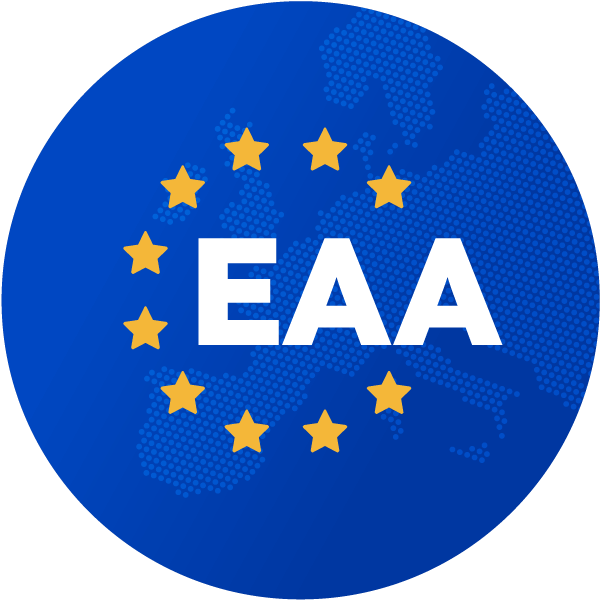
Who does the EAA apply to?
Unless your organisation has fewer than 10 employees or an annual turnover below €2 million, the EAA applies if you provide any of the following products or services within the EU market:
- Websites and mobile apps
- E-books and e-readers
- Online banking services
- E-commerce platforms
- Ticketing and self-service terminals (e.g., ATMs, check-in kiosks).
The EAA is relevant to both private sector companies (like e-commerce, fintech, and software vendors) and public sector suppliers, where national legislation brings them into scope.
Checking for EAA compliance is now easier than ever. At Recite Me, we offer a free website audit to spot any issues related to the European Accessibility Act and WCAG. You’ll get a clear action plan to help improve your website’s accessibility and meet EAA compliance.
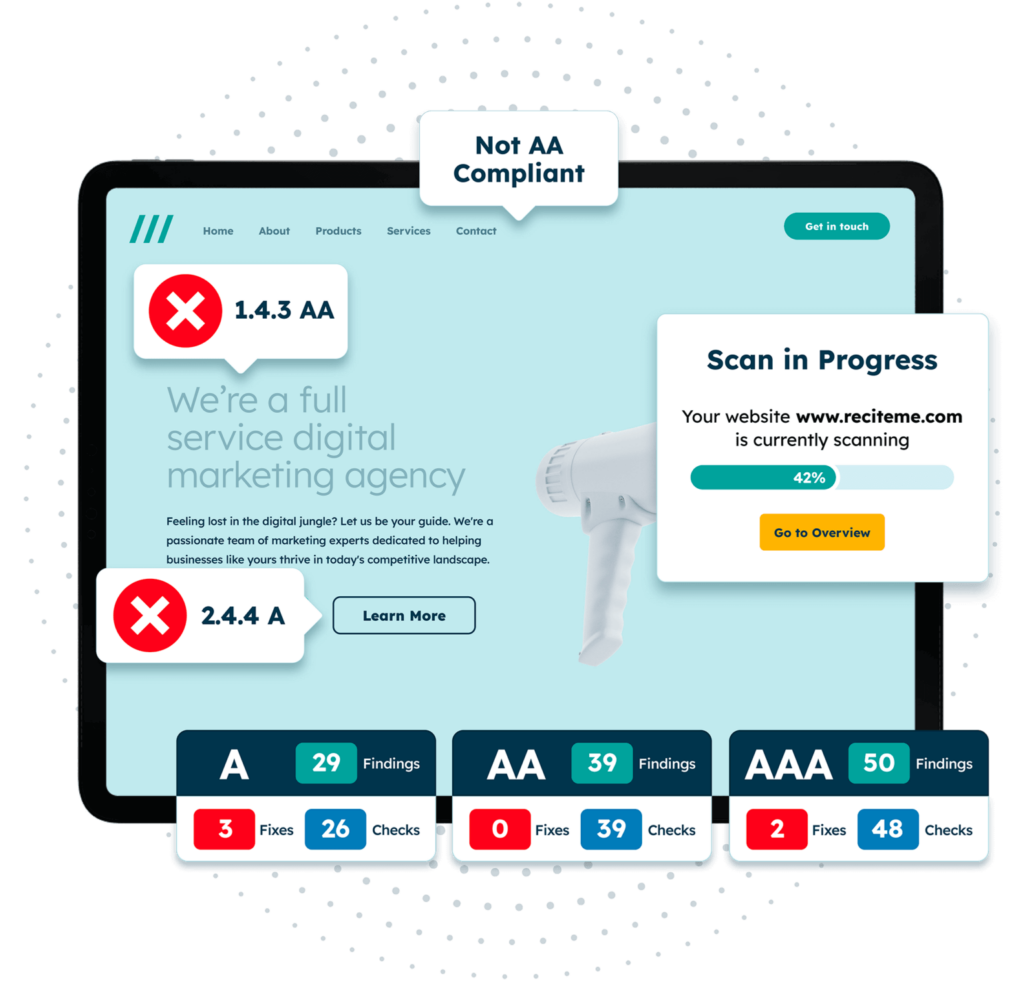
Do UK companies need to be EAA compliant?
In short: yes. The EAA applies extraterritorially, meaning any business offering relevant products or services to EU consumers must comply, even after Brexit (provided they meet the size/turnover thresholds). Examples include:
- UK software companies offering a cloud-based platform used by EU clients.
- UK-based online retailers shipping goods into the EU.
- Digital publishing companies selling e-books in EU markets.
When do UK companies need to comply with EAA guidelines?
The European Accessibility Act sets out two key compliance deadlines:
- 28 June 2025: All new digital products and services placed on the EU market from this date must comply with EAA requirements.
- 28 June 2030: All existing products and services made available before 2025 must be brought into compliance by this extended deadline, if they remain on the market.

In short:
- If you’re planning to launch new digital offerings in the EU, you must meet accessibility requirements by 28 June 2025.
- If you already serve EU customers, ensure your legacy platforms and content are accessible by 28 June 2030.
We strongly advise planning ahead. The longer you wait, the harder it will be to catch up, and in the meantime, you risk losing access to key markets.
What are the risks for non-compliant UK companies?
Market reach should be a significant concern. After all, enhanced accessibility is a competitive advantage. However, there are plenty more potential consequences, and some are severe:
- Administrative EAA compliance fines of up to €20,000 per violation.
- Daily fines of up to €1,000 until resolution.
- Legal enforcement from EU member states.
- Non-compliance lawsuits.
- Restricted access to EU markets for non-compliant products or services.
- Reputational damage, which could be significant given the growing public and corporate awareness around digital inclusion.
- Contractual limitations when bidding for EU government or enterprise tenders that require EAA compliance.
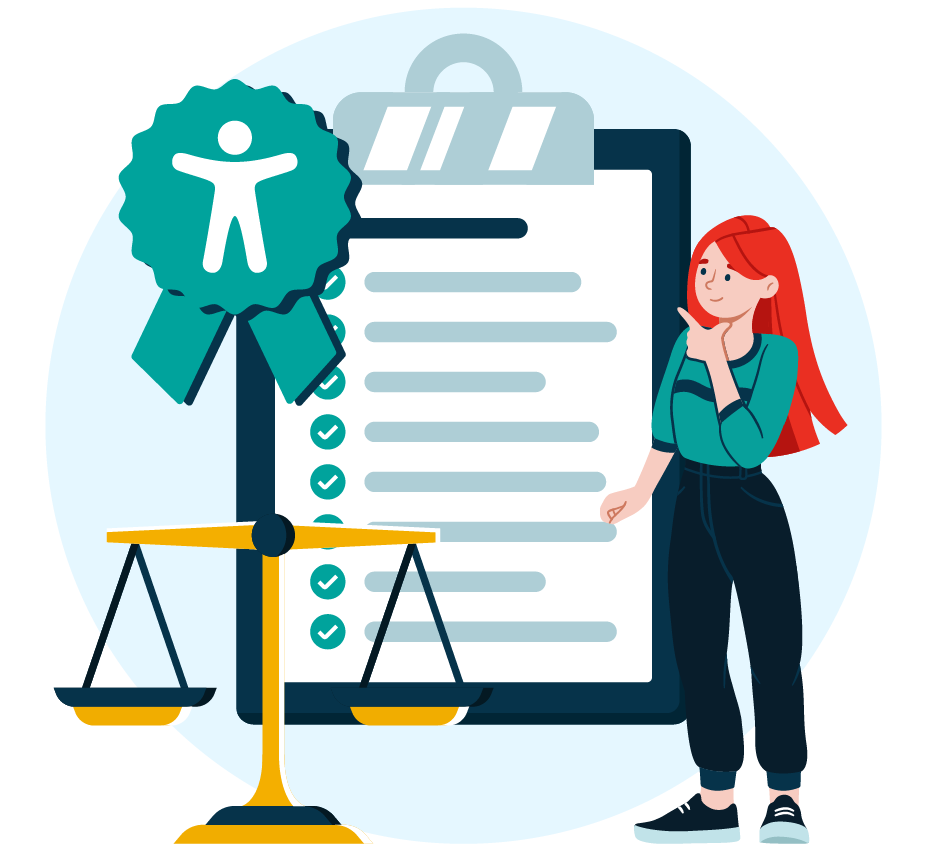
Remember: It doesn’t matter if your business is headquartered outside the continent. Any UK-based business operating within the EU market is subject to EAA regulations.
How does EAA integrate with existing UK accessibility legislation?
The EAA does not override UK law. Rather, it complements the UK’s own existing digital accessibility legislation. Many of the standards and principles are already aligned, making it easier to integrate EAA compliance into your existing digital accessibility strategy.
The Public Sector Bodies (Websites and Mobile Applications) Accessibility Regulations 2018
The Public Sector Bodies Accessibility Regulations 2018 is a UK law that requires public sector organisations to make their websites and mobile applications accessible to all users, including people with disabilities.

The regulations apply to the following entities:
- Central and local government departments.
- NHS trusts and public health bodies.
- Universities, colleges, and publicly funded schools.
- Publicly owned utilities and transport authorities.
Applicable organisations are required to meet WCAG 2.1 Level AA standards, publish a detailed accessibility statement, and proactively identify and fix known accessibility issues.
The Equality Act 2010
The Equality Act is the primary UK legislation that protects people, including individuals with disabilities, from discrimination. It places a duty on organisations to make reasonable adjustments to ensure equitable access to both physical and digital spaces.
What are the standards for EAA compliance in the UK?
To avoid running into any grey areas or winding up in legal hot water, UK companies should comply with the Web Content Accessibility Guidelines (WCAG) 2.1 Level AA. Key requirements include:
- Providing alt text for images and non-text content (WCAG success criterion 1.1.1).
- Ensuring sufficient colour contrast between text and background (WCAG success criterion 1.4.3).
- Implementing keyboard navigation support for all interactive elements (WCAG success criterion 2.1.1).
- Providing clear labels and instructions for online forms (WCAG success criterion 3.3.2).
- Ensuring consistent navigation across pages (WCAG success criterion 3.2.3).
- Adding captions for video content (1.2.2) and audio descriptions or transcripts for multimedia (1.2.5).
- Optimising for responsive layouts and mobile accessibility (1.4.10: Reflow, and 2.5.1: Pointer Gestures).
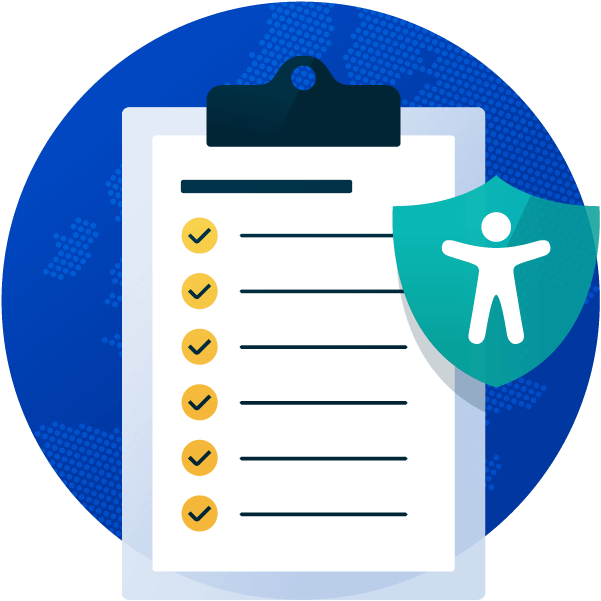
These aren’t just technical checkboxes. They improve usability for vulnerable consumers, including low-income individuals, older adults, veterans, people with disabilities, ESL (English as a Second Language) speakers, and those with low literacy or a cognitive disability.
Steps to take for UK EAA compliance
Here is a practical, four-step roadmap UK companies can follow to meet EAA requirements and futureproof their digital operations.

1. Conduct an accessibility audit of your website
Use automated tools like Recite Me’s Website Accessibility Checker for a fast, accurate baseline report of how your website stacks up against WCAG criteria. Pair this with manual tests to check:
- Keyboard navigation
- Screen reader compatibility
- Colour contrast
- Form accessibility
The best audits combine both technical and UX elements, focusing on content and interaction barriers in addition to code-level failures.
2. Implement the fixes from your audit
Review your findings and involve both developers and content teams in prioritising issues based on:
- Severity
- Frequency
- Legal risk
Typical accessibility remediation tasks include adding missing alt text, fixing low contrast colours, adding transcripts and captions for multimedia content, and ensuring all buttons and links are accessible using only the Tab, Enter, and Arrow keys.
3. Schedule future audits for long-term compliance
EAA compliance isn’t a one-off project. It’s an ongoing process that requires a long-term plan. You’ll need to:
- Schedule accessibility reviews at least quarterly, or before major releases.
- Conduct regression testing as part of your QA and deployment cycles.
- Assign ownership of accessibility within your teams.
- Maintain documentation of all updates and fixes for future audits or legal queries.
Pro tip: Integrate accessibility testing into development workflows to catch issues early using tools like linters or CI/CD automation.

4. Providing EAA training to key contributors
Ensure that everyone involved in digital production, including designers, developers, content writers, and product managers, has a working understanding of accessibility standards and EAA obligations. Provide training on:
- WCAG versions and EAA compliance criteria.
- Inclusive UX/UI best practices.
- Accessible content writing.
- Legal responsibilities under both UK and EU laws.
You may also wish to work with third-party accessibility consultancy experts to ensure tailored guidance, training, and ongoing support.
Make sure your website meets the European Accessibility Act with our easy-to-follow EAA checklist. It covers all the key steps to get compliant before the deadline and helps you avoid penalties. Get started today!
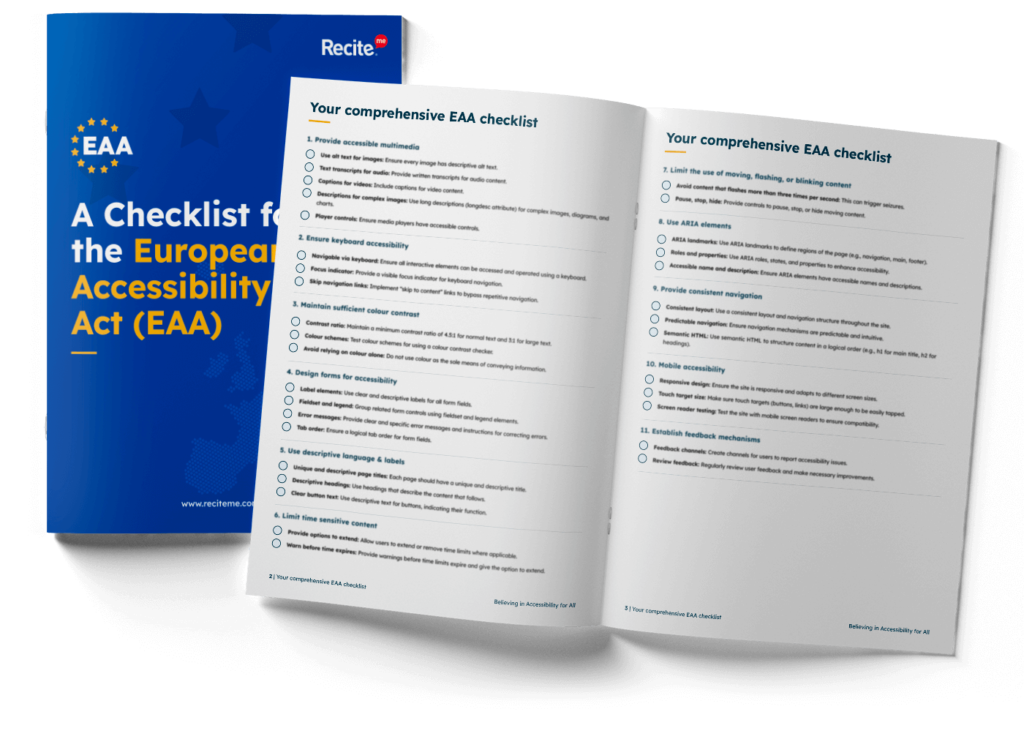
Don’t Wait. Get Compliant Today!
The European Accessibility Act is one of the most significant shifts in digital regulation in recent years. Compliance is not optional, so if your organisation operates in the EU market and falls within scope, now is the time to act. The earlier you begin, the easier it is to keep pace with changing standards and stay competitive in an increasingly accessible digital world.
Don’t wait to get started. Book a free EAA accessibility check today to get an instant accessibility score for your website, and contact our team for tailored guidance based on the unique needs of your business.
EAA Compliance in the United Kingdom FAQs
Here are some common questions from UK organisations looking to understand their obligations under the European Accessibility Act.
Does the European Accessibility Act apply in the UK after Brexit?
Yes. The EAA applies extraterritorially, which means UK-based businesses must comply if they provide relevant digital products or services to EU consumers, regardless of Brexit.
What types of UK businesses need to comply with the EAA?
Microenterprises are generally exempt. Outside of this, the EAA applies to any UK company that:
- Offers covered products or services to EU customers.
- Has 10 or more employees or a turnover of more than €2 million annually.
How do I check my website for EAA compliance?
To check your current status, you can use accessibility tools such as the Recite Me Website Accessibility Checker, which scans for WCAG violations and offers actionable guidance.
What is the difference between the EAA and the UK Equality Act 2010?
The Equality Act is an anti-discrimination law that applies broadly but focuses on the duty to make reasonable adjustments for individuals. The EAA is a product and service regulation that requires accessibility by design and applies across multiple sectors.
Does EAA compliance ensure Equality Act compliance?
No, not necessarily. Both laws support accessible and inclusive digital practices, but EAA compliance does not automatically mean Equality Act compliance, and vice versa.
Need more help becoming EAA compliant?
The following resources are packed full of actionable tips and expert advice for making your digital content compliant with the European Accessibility Act:
Free EAA Compliance Training
Take the first step to European Accessibility compliance by completing our EAA training course.
Free EAA Compliance Guide
Ensure your organisation is meeting the necessary requirements for European Accessibility Act compliance.
Free EAA Audit of your Website
Download a free accessibility check of your website. This report will highlight any EAA non-compliance and how to fix it.


